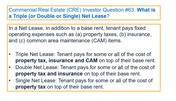Glossary of REIT terms
NOI (Net Operating Income) - Total property level operating revenue less total property operating expenses. If thinking about REITs versus other types of business, NOI is akin to adjusted EBITDA but adds back central overhead expenses. The rationale for doing so is that Note that the NOI used by Private Eye is more conservative than what companies report because it DOES deduct central property management expenses.
Cap Rate - NOI divided by property value
Implied cap rate - company NOI divided by total capitalization of company (market cap + preferred equity + net debt - development - other).
LTV (Loan to Value) = % of debt used to finance the property or portfolio. LTV =debt / property value. Typically 50-80% in the private market. In the public (REIT) market, LTVs are typically below 35%.
Enterprise Value = total capitalization (defined below)
Total Capitalization - market cap + preferred equity + net debt - development - other
Economic Occupancy - percent of units physically occupied and paying rent
Physical Occupancy - percent of units physically occupied
Loss to lease - a measure of rents received versus current market for rent. Loss to lease implies that the property has below market rents (losing due to current lease terms). While 'loss' has a negative connotation, this is actually positive as it means there is room to raise rents which are below market value.
Development yield - NOI divided by total cost of development.
Lease up - a property which has received its occupancy certificate and is in its initial leasing phase (unlike other property types like office, industrial, and retail apartment properties start at 0% occupancy). After completing lease up (90% occupancy for 90 days), a property is considered 'stabilized'.
Stabilized property - once initial lease up has been completed and the property has achieved 90% occupancy for 90 days
Same store portfolio
Non recourse loan (NRL) - a loan that is backed only by the property itself. The most common type of non recourse loan is simply a mortgage on the property.
Yield spread- cap rate less 10 year Treasury rate
Maintenance or recurring capital expenditure (capex) - non-revenue generating capital expenditure required to maintain the current value/condition of the units/property



